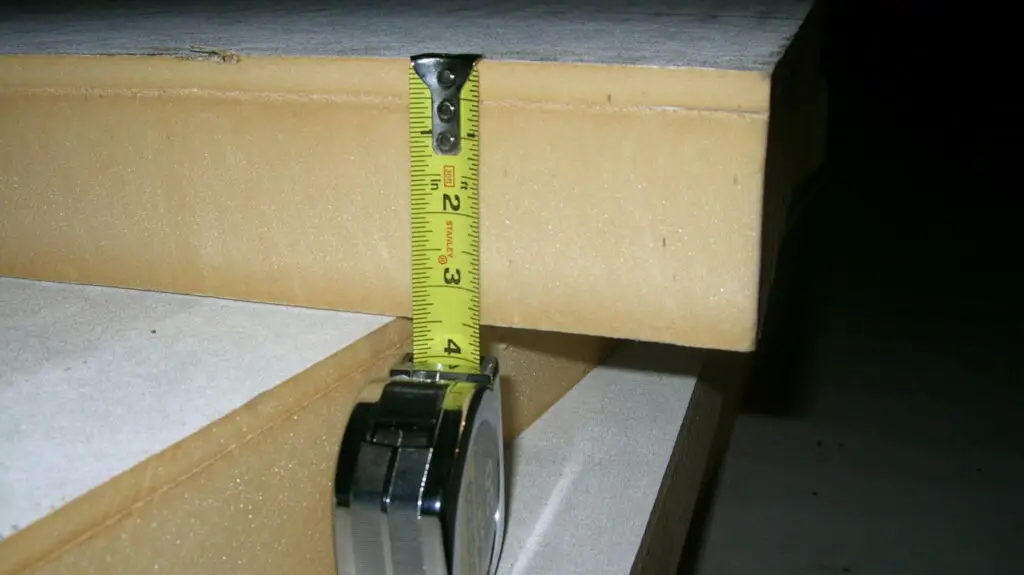R-Value Chart • 38 Types of Insulation & Roofing Materials
(Includes RSI Values)
By Jack Gray, Roof Online Editor • Last updated September 30, 2023
To learn more about R-value, see our article Introduction to R-Value.
Table of Contents
- About This R-Value Chart
- Check with the Manufacturer
- R-Value vs. RSI
- R-Value and Energy Codes
- Table: R-Value Chart for 38 Materials
- Related Pages

About This R-Value Chart
The following R-value chart provides typical roof insulation R-values, other building insulation R-values, and the R-value of roofing materials like shingles and single-ply membranes (roof covering materials), as well as a few other building materials. RSI values are given as well.
These R-values were taken from manufacturer technical data sheets and are the reported R-values per inch of actual products. In a few cases, the R-values we give were taken from a non-manufacturer source that we consider trustworthy and accurate.
In all cases, this R-value chart is intended only as a general guide to material R-values, and the R-values of specific products may be somewhat different from the R-value we give for that type of material.
Check with the Manufacturer
If you’re trying to calculate precise roof R-value for a real-life installation, you should always refer to the manufacturer’s product data sheets for the actual, specific product that you are using or planning to use.
You can also contact the technical department of the product manufacturer or material provider; the people who work in technical departments look forward to getting phone calls and getting a chance to explain things and they’ll be happy to answer any questions you might have.
Most manufacturers put the phone number for their technical department on the contact page of their websites.
R-Value vs. RSI
R-value is used in the United States. RSI (R-value Système International) is the metric equivalent.
To convert the R-value of a specific thickness of a material to RSI, divide the R-Value by 5.67826. To convert RSI to R-value, multiply the RSI by 5.67826.
For example, two inches of extruded polystyrene, with an R-value of 11, has an RSI of 1.93721 (11 divided by 5.67826).
R-Value and Energy Codes
Please note that the R-values for roof membranes, shingles, tiles, air films, and roof deck materials will probably not be permitted by your local code to be included when total roof assembly R-value is being calculated for the purpose of satisfying energy code requirements.
Always check with your local code authority to find out your current local R-value requirements as well as which materials or parts of a building component you are permitted to use when you calculate the total R-value of a system.
Table: R-Value Chart for 38 Materials
Note: While the R-value for a material is typically given per inch, the RSI is typically given per millimeter, so please be aware that the R-Values and RSI values for the materials in the following R-value chart are not for equivalent thicknesses.
Note: Our R-value chart provides R-values for roof coverings such as roof shingles and single-ply roof membranes. These R-values are the totals for the typical as-installed thicknesses of those materials. They are not R-values per inch for the material.
| R-Value of Roofing Materials and Building Insulation | ||||
|---|---|---|---|---|
| Material | R-Value per Inch (ft²·°F·hr/BTU) | RSI per Millimeter (K·m²/W) | R-Value for TYPICAL INSTALLED Thickness (NOT per Inch) |
Source |
| Asphalt Shingles | 0.44 | National Roofing Contractors Association | ||
| Built-up Roof Membrane, Gravel-Surfaced (Membrane and Gravel Only) | 0.33 | National Roofing Contractors Association | ||
| Built-up Roof Membrane, Smooth-Surfaced (Membrane Only) | 0.24 | National Roofing Contractors Association | ||
| Cellulose, Blown (Attic) | 3.8 | 0.02638 | Cellulose Insulation Manufacturers Association | |
| Cellulose, Blown (Wall) | 3.8 | 0.02638 | Cellulose Insulation Manufacturers Association | |
| Cellulose, Wet Spray | 3.75 | 0.02598 | International Cellulose Corporation | |
| Concrete, Lightweight Insulating | 0.90 – 1.49 | 0.00630 – 0.01024 | Siplast | |
| Concrete, Structural (140 pcf) | 0.08 | 0.00040 | Siplast | |
| EPDM Roof Membrane, Ballasted (Membrane and Ballast Only) | 0.33 | National Roofing Contractors Association | ||
| EPDM Roof Membrane, Fully-Adhered or Mechanically-Attached (Membrane Only) | 0.24 | National Roofing Contractors Association | ||
| Fiber Cement Shingles | 0.21 | National Roofing Contractors Association | ||
| Fiberglass, Batt | 3.14 – 4.29 | 0.02165 – 0.02992 | Johns Manville | |
| Fiberglass, Blown (Attic) | 2.12 – 4.0 | 0.01457 – 0.02756 | Johns Manville | |
| Fiberglass, Blown (Wall) | 4.0 – 4.3 | 0.02756 – 0.02992 | Johns Manville | |
| Fiberglass, Rigid Board | 4.3 – 4.5 | 0.02992 – 0.03110 | Johns Manville | |
| Gypsum Board | 0.90 – 1.12 | 0.00630 – 0.00787 | United States Gypsum Company; Georgia-Pacific | |
| Metal Roof Panels | No Useful R-Value | National Roofing Contractors Association | ||
| Mineral Wool, Batt | 4.0 – 4.22 | 0.02756 – 0.02913 | Owens Corning | |
| Mineral Wool, Blown (Attic) | 2.95 – 3.39 | 0.02047 – 0.02362 | Owens Corning; American Rockwool Manufacturing | |
| Mineral Wool (Rigid Board) | 3.8 | 0.02638 | Rockwool Group | |
| Modified Bitumen Roof Membrane, Granule-Surfaced (Membrane Only) | 0.15 | National Roofing Contractors Association | ||
| Oriented Strand Board (OSB) | 1.0 – 1.24 | 0.00709 – 0.00866 | University of Minnesota | |
| Perlite Cover Board | 2.64 | 0.01811 | Johns Manville | |
| Phenolic Foam Board | 6.7 – 7.5 | 0.04646 – 0.05197 | Dow Chemical Company | |
| Plywood | 1.0 – 1.24 | 0.00709 – 0.00866 | University of Minnesota | |
| Polyiso Insulation (Polyisocyanurate) | 5.0 (NRCA) 5.7 (PIMA) |
0.03465 (NRCA) 0.03937 (PIMA) |
National Roofing Contractors Association; Polyisocyanurate Insulation Manufacturers Association |
|
| Polystyrene, Expanded (EPS) | 3.85 – 4.5 | 0.02677 – 0.03110 | Insulation Technology, Inc.; ACH Foam Technologies | |
| Polystyrene, Extruded (XPS) | 5.0 – 5.5 | 0.03465 – 0.03819 | XPSA (Extruded Polystyrene Foam Association) | |
| PVC Roof Membrane, Fully-Adhered or Mechanically-Attached (Membrane Only) | 0.24 | National Roofing Contractors Association | ||
| Slate Roofing | 0.05 | National Roofing Contractors Association | ||
| Sprayed Polyurethane Foam (Closed Cell)) | 4.9 – 7.1 | 0.03386 – 0.04921 | Icynene, Inc. | |
| Sprayed Polyurethane Foam (Open Cell) | 3.7 – 4.0 | 0.02559 – 0.02756 | Icynene, Inc. | |
| Tile Roofing, Including Batten System and Air Space | 2.95 | Boral Roofing | ||
| TPO Roof Membrane, Fully-Adhered or Mechanically-Attached (Membrane Only) | 0.24 | National Roofing Contractors Association | ||
| Wood Fiberboard | 2.5 | 0.01732 | Blue Ridge Fiberboard, Inc | |
| Wood Shakes and Shingles (Cedar) |
0.94 | National Roofing Contractors Association | ||
| Wood (Typical Hardwood) | 0.7 | 0.00472 | U.S. Department of Energy | |
| Wood (Typical Softwood) | 1.4 | 0.00984 | U.S. Department of Energy | |
About the Author
Jack Gray is a principal roof consultant and vice president at the Moriarty Corporation, an award-winning building enclosure consultant firm founded in 1967. He is also the editor of the Roof Online website.

Mr. Gray has worked in the roofing industry for over 25 years, with training and practical experience in roof installation, roof inspection, roof safety, roof condition assessment, construction estimating, roof design & specification, quality assurance, roof maintenance & repair, and roof asset management.
He was awarded the Registered Roof Observer (RRO) professional credential in 2009.
He also served as an infantry paratrooper in the 82nd Airborne Division and has a B.A. from Cornell University. Read full bio.
